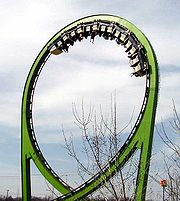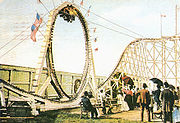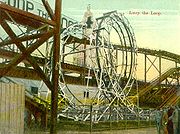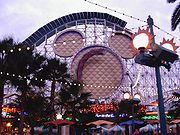.gif)
Loop (roller coaster)
Encyclopedia
 |
 |
 |
 |
The generic roller coaster
Roller coaster
The roller coaster is a popular amusement ride developed for amusement parks and modern theme parks. LaMarcus Adna Thompson patented the first coasters on January 20, 1885...
vertical loop is the most basic of roller coaster inversions. Specifically, the loop refers to a continuously upward-sloping section of track that eventually results in a complete 360 degree circle. At the top-most piece of the loop, riders are completely inverted.
History
The vertical loop is not a recent roller coaster innovation. Its origins can be traced back to the 1850s when Centrifugal RailwayCentrifugal Railway
Centrifugal railway was the name of a number of early looping roller coasters that were built in Western Europe in the middle of the 19th century. The rides were similar in their basic design to many modern day shuttle roller coasters , but with only one lift hill and no launch...
s were built in France and Great Britain. The rides relied on centripetal force
Centripetal force
Centripetal force is a force that makes a body follow a curved path: it is always directed orthogonal to the velocity of the body, toward the instantaneous center of curvature of the path. The mathematical description was derived in 1659 by Dutch physicist Christiaan Huygens...
s to hold the car in the loop. One early looping coaster was shut down after an accident.
Later attempts to build a looping roller coaster were carried out during the late 19th century with the Flip Flap Railway at Sea Lion Park
Sea Lion Park
Sea Lion Park was a amusement park started in 1895 on Coney Island by Paul Boyton. He fenced the property and charged admission, the park becoming the first enclosed and permanent amusement park in North America. Up until the establishment of this park, amusement areas around the country consisted...
. The ride was designed with a completely circular loop (rather than the teardrop shape used by many modern looping roller coasters, see below), but caused neck injuries due to the intense G-forces pulled with the tight radius of the loop.
The next attempt at building a looping roller coaster was in 1901 when Edwin Prescott built the Loop-the-Loop at Coney Island
Coney Island
Coney Island is a peninsula and beach on the Atlantic Ocean in southern Brooklyn, New York, United States. The site was formerly an outer barrier island, but became partially connected to the mainland by landfill....
. This ride used the modern teardrop-shaped loop and a steel structure, however more people wanted to watch the attraction, rather than ride. No more looping roller coasters were built until 1976 when The Shockwave opened at Six Flags Over Texas,and following shortly afer, the Revolution
Revolution (roller coaster)
The Revolution, formerly known as Great American Revolution and La Revolución, is a steel roller coaster manufactured by Anton Schwarzkopf of Germany and designed by Werner Stengel. The coaster is located in the Baja Ridge area of Six Flags Magic Mountain in Valencia, California...
opened at Six Flags Magic Mountain
Six Flags Magic Mountain
Six Flags Magic Mountain is a theme park located in Valencia, California north of Los Angeles. It opened on Memorial Day weekend on May 30, 1971 as Magic Mountain, by the Newhall Land and Farming Company. In 1979, Six Flags purchased the park and added the name Six Flags to the park's title. In...
. In 2000, a modern looping wooden roller coaster
Wooden roller coaster
A wooden roller coaster is most often classified as a roller coaster with laminated steel running rails overlaid upon a wooden track. Occasionally, the structure may be made out of a steel lattice or truss, but the ride remains classified as a wooden roller coaster due to the track design...
was built, the Son of Beast at Kings Island
Kings Island
Kings Island is a amusement park located northeast of Cincinnati in Mason, Ohio. Opened in 1972 by Taft Broadcasting Company and now owned by Cedar Fair Entertainment Company, Kings Island is the most visited seasonal amusement park in the U.S...
. Although the ride itself was made of wood, the loop was supported with steel structure. Due to maintenance issues however, the loop was removed at the end of the 2006 season. The loop was not the cause of the ride's issues, but was removed as a precautionary measure—thus, it is in fact the only successful installation of a loop on a modern wooden roller coaster.
Loops on non-rollercoasters
Designers of other rides have been tempted sometimes to include similar loops, although safety concerns usually lead them to quickly reconsider.In 1980 at New Jersey
New Jersey
New Jersey is a state in the Northeastern and Middle Atlantic regions of the United States. , its population was 8,791,894. It is bordered on the north and east by the state of New York, on the southeast and south by the Atlantic Ocean, on the west by Pennsylvania and on the southwest by Delaware...
's infamous Action Park
Action Park
Action Park was an amusement park, open from 1978 to 1996 in Vernon Township, New Jersey at the former Vernon Valley / Great Gorge ski area, now known as Mountain Creek....
, a loop was built into a covered water slide
Water slide
A water slide is a type of slide designed for warm-weather or indoor recreational use at water parks. Water slides differ in their riding method and therefore size...
. Riders were warned to descend with their legs crossed and arms across the chest to traverse the loop safely. Too many ignored this instruction, however, and either got stuck atop the loop (requiring the construction of an access hatch to free them) or injured themselves, or both. It was closed after a month, and would open at somewhat random intervals until around 1995. It is not known if the ride was reported as being open during Action Park's last year of operation in 1996.
It has been dismantled since then and will probably not be rebuilt. As of 2006, no other looping water slides have opened at any parks. However, since 2002, the Swiss company Klarer Freizeitanlagen AG has been working on a safe design for a looping water slide and have now built and tested a 1:1 prototype of their design. Since then, multiple installations of the slide, named the AquaLoop, have appeared in many parks.
Physics/Mechanics
In actuality, most roller coaster loops are not circular in shape. A commonly used shape for loops is the clothoid loop, which resembles an inverted tear drop and allows for less intense G-forces throughout the element for the rider. The name comes from the incorporation of sections from the mathematical clothoid spiral curve in the shape of the loop.The use of this shape was pioneered in 1975, on Revolution
Revolution (roller coaster)
The Revolution, formerly known as Great American Revolution and La Revolución, is a steel roller coaster manufactured by Anton Schwarzkopf of Germany and designed by Werner Stengel. The coaster is located in the Baja Ridge area of Six Flags Magic Mountain in Valencia, California...
at Six Flags Magic Mountain
Six Flags Magic Mountain
Six Flags Magic Mountain is a theme park located in Valencia, California north of Los Angeles. It opened on Memorial Day weekend on May 30, 1971 as Magic Mountain, by the Newhall Land and Farming Company. In 1979, Six Flags purchased the park and added the name Six Flags to the park's title. In...
, by Werner Stengel
Werner Stengel
Werner Stengel is a German roller coaster designer and engineer. Stengel is the founder of Stengel Engineering, also known as Ingenieur Büro Stengel GmbH ....
of leading coaster engineering firm Ing.-Büro Stengel GmbH.
On the way up, from the bottom to the top of the loop, gravity is in opposition to the direction of the cars and will slow the train. The train is slowest at the top of the loop. Once beyond the top, gravity helps to pull the cars down around the bend. If the loop's curvature is constant, the rider is subjected to the greatest force at the bottom. If the curvature of the track changes suddenly, as from level to a circular loop, the greatest force is imposed almost instantly (see jerk). Gradual changes in curvature, as in the clothoid, reduce the force maximum (permitting more speed) and allow the rider time to cope safely with the changing force.
Obviously this "gentling" runs somewhat contrary to the coaster's raison d'être. Schwarzkopf
Anton Schwarzkopf
Anton Schwarzkopf was a German engineer of amusement rides, and founder of the Schwarzkopf Industries company, which built numerous rides and large roller coasters for both amusement parks and travelling funfairs....
-designed roller coasters often feature near-circular loops (in case of Thriller
Zonga
Zonga was a steel tracked looping roller coaster at Six Flags Marine World from 2003 to 2005. It was designed by Anton Schwarzkopf. The coaster was previously at Six Flags Astroworld as "Texas Tornado", and before that toured the German funfair circuit as "Thriller"...
even without any reduction of curvature between two almost perfectly circular loops) resulting in intense rides—a trademark for the designer.
It is rare for a roller coaster to stall
Stall (roller coaster)
A roller coaster is said to have stalled, a roll back, saddle, or valleyed if it is unable to complete the course because of energy loss. This can be caused by friction between the track and wheels, or in the wheel bearings. Weather can also cause a coaster to valley...
in a vertical loop, although this has happened before. Turbine (then known as Sirocco) at Walibi Belgium
Walibi Belgium
Walibi Belgium, formerly Walibi Wavre and then Six Flags Belgium, is a Belgian theme park located in Wavre, close to Brussels. During the 1998 to 2004 period, it was owned by Six Flags, Inc, an American theme park operator. It was later sold to Palamon Capital Partners...
once stranded riders upside-down for several hours. The design of the trains and the rider restraint system (in this case, a simple lap bar) prevented any injuries from occurring, and the riders were removed with the use of a cherry picker
Cherry picker
A cherry picker , is a type of aerial work platform that consists of a platform or bucket at the end of a hydraulic lifting system.- Design :...
.
External links
- Ing.-Buero Stengel GmbH
- Loop Shapes in Roller Coasters (originally referenced link is dead now)

